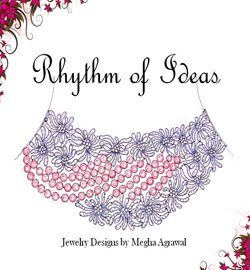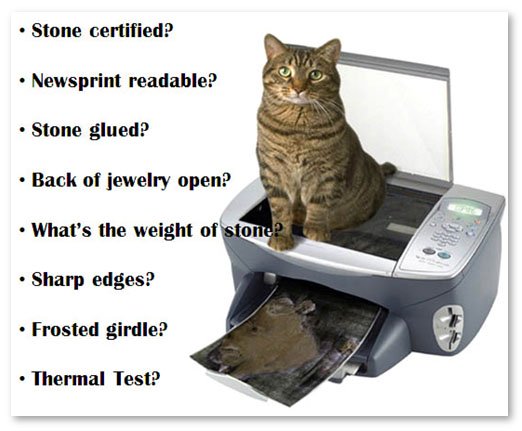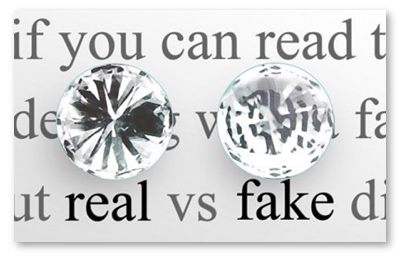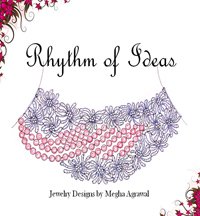Difference between Natural Diamond and Simulants
How can you differentiate between Natural Diamond and Simulants?
Let me tell you honestly, unless you are an expert or without consulting an expert you cannot be sure about the identification of a stone.
There are so many diamond look-a-likes available in the market (white sapphire, cubic zirconia, moissanite, white topaz etc.) that as outsider you may not find easy to differentiate between - of course until and unless you are aware of some DIY tests.
Here, I am talking about your valuable money that you intend to invest. So, why take the chance! If you have slightest of doubt about the diamond you are considering, have it certified from a professional organization or show it to your local jeweler.
However, there are few simple tests that you
can perform yourself to know if it’s a natural diamond or a copycat. If the stone in question doesn't pass any of these checks, then it is definitely not a diamond.
Is the stone certified?
Ask for the certificate; if it’s a genuine stone it can be certified by any authorized gem grading institute (like - GIA, AGS, CIBJO, HRD) or any individual appraiser who is affiliated with such professional organization.
Reputed jewelers name is sufficient but certification is very important if you are considering buying an antique or heirloom ring from other source, or while buying the stone you haven’t seen like - online buying.
Is newsprint readable through the stone?
If the stone is round, modern-cut, loose or is mounted (set in jewelry) in such a way as to allow you to place it table–down (upside down) over newsprint, check whether you can read or see any portion of the lettering.
If you can read the letters, it means it is not a diamond. Refraction of light (the degree to which incident ray of light is bent upon entering the stone) within a genuine diamond is so high that you will not be able to see any of the letters in the newsprint.
In case of a mounted stone, if it is a genuine diamond then you will not be able to see the bottom if you are viewing from the top of the stone.
Real diamond (left) and Simulant (right)
Is the stone glued into the settings?
Diamonds are seldom glued in but rhinestones often are. So, this can also be one of the criteria for making out the difference.
Is the back of jewelry open or closed?
If the stone is a properly set diamond, the back of the setting will usually be open, allowing you to easily see a portion of the pavilion. I have said usually because diamond set in antique jewelry can have closed back.
Also, nowadays on customers’ demand, designers like me design jewelry pieces with closed back to give it an antique look and feel. So, in case of antique or customized jewelry, this criterion of open or closed back cannot be used to differentiate between diamond and its impostors in a sure shot manner.
Otherwise, this criterion can be used for differentiating diamond and its fake counterparts, because back of the latter are closed to conceal foil cover applied to the back of simulants to increase their brilliance.
However, having
said that, sometimes real diamonds are mounted with close back as well.
This is due to metal in area of mounting being narrow or prone to
bending when subjected to even a moderate force. In this case holes are
not drilled for diamond setting and mounting is done with close back.
If the stone is not mounted, or if it can be easily removed from the setting, have it weighed.
Cubic Zirconia or CZ is approximately 75% heavier than a diamond of the same size.
For example 6.5mm diamond weighs 1 carat, while same sized CZ weighs 1.75 carats. So a CZ that looks like a 1 carat diamond in terms of its size will actually weigh 1.75 carats.
Are the edges of the stone sharp?
Check the edges of the stone. Simulants have slightly rounded or chipped edges as compared to sharp edges of diamonds.
Is the Girdle of the stone frosted?
Check the girdle. If it is frosted, a subdued whiteness resembling slightly wet or oiled frosted glass will indicate it is a CZ diamond. In case of a real diamond, its girdle is transparent and sparkling.
Has the stone passed the Thermal Test?
Diamond is thermal conductor, therefore it will easily pass the thermal test, while simulants don’t pass this test because of their low thermal conductivity. Using this thermal conductivity property, you can also perform the "Fog Test" to verify it's diamond or not.
Exhale out hot air on the given stone, just like you do on a glass or mirror. If it'll be a real diamond then it will not fog-up and become clear instantly. This is because diamond being good thermal conductor, it will not retain heat. On the other hand, fake stone will remain fogged-up for a short period.
Does the stone sparkle with enormous rainbow color?
Usual viewpoint is, diamond sparkle with lot of rainbow color. However, this is not at all true. On the contrary, a real diamond will not show much rainbow light effect. It will display the light-splitting effect (rainbow) only on its surface (also termed "Fire"), while from inside it will just show a gray light reflection (also termed "Brilliance").
Therefore, if you find a sparkling stone emitting rainbow colored light from inside, then it means it's not a real diamond.
So, keep in mind the above-mentioned points while buying diamond. This should help you while taking decision of buying diamond.
Return from Natural Diamond and Simulants to Diamond Information page
Return from Natural Diamond and Simulants to Diamond Jewelry Homepage
I hope you'll not mind sharing this on Twitter, Facebook and with everyone else :)
Feel free to share if something is in your mind and want it to be covered on this site.
My Newsletter
Did you liked this article? Sign-up my FREE weekly newsletter and I'll send you more awesome new additions on this website along with latest jewelry happenings around the world, and download my Jewelry Design Album for FREE!
 |
|




